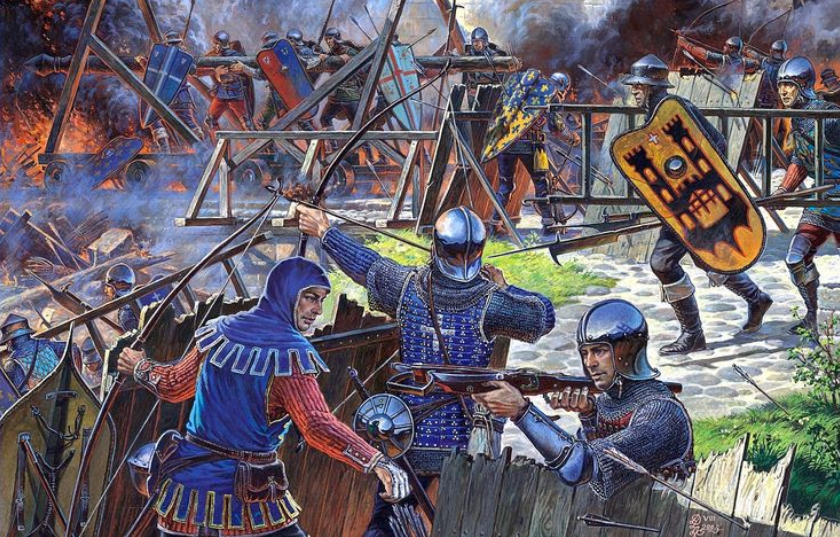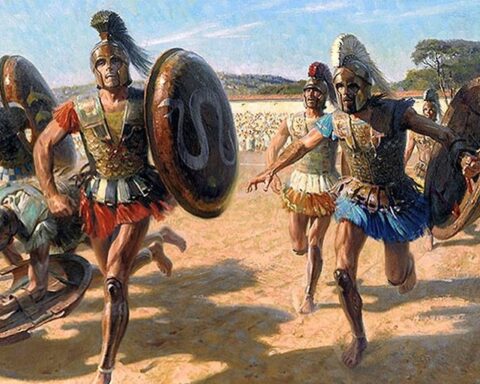Editor’s note: The following is extracted from Military Manners and Customs, by James Anson Farrer (published 1885). It is offered here not for its semi-pacifist perspective, but as a useful corrective to the romanticized view of medieval warfare. All spelling in the original.
“Voi m’avete fatto tornare quest’arte del soldo quasi che nulla, ed io ne l’aveva presupposta la più eccellente e la più onorevole che si facesse.”
—Machiavelli, Dell’Arte della Guerra.
For an impartial estimate of the custom of war, the best preparation is a study of its leading features in the days of chivalry. Not only are most of our modern military usages directly descended from that period, though many claim a far remoter ancestry, and go back to the days of primitive savagery, but it is the tradition of chivalry that chiefly keeps alive the delusion that it is possible for warfare to be conducted with humanity, generosity, and courtesy.
Hallam, for instance, observes that in the wars of our Edward III, ‘the spirit of honourable as well as courteous behaviour towards the foe seems to have arrived at its highest point;’ and he refers especially to the custom of ransoming a prisoner on his parole, and to the generous treatment by the Black Prince of the French king taken captive at Poitiers.
In order to demonstrate the extreme exaggeration of this view, and to show that with war, as with the greater crimes, moral greatness is only connected accidentally, occasionally, or in romance, it is necessary to examine somewhat closely the warfare of the fourteenth century. Chivalry, according to certain historians, was during that century in process of decline; but the decline, if any, was rather in the nature of its forms and ceremonies than of its spirit or essence. It was the century of the most illustrious names in chivalry, in France of Bertrand du Guesclin, in England of the Black Prince, Sir Walter Manny, Sir John Chandos. It was the century of the battles of Crecy, Poitiers, Avray, and Navarette. It was the century of the Order of the Star in France, of the Garter and the Bath in England. Above all, it was the century of Froissart, who painted its manners and thoughts with a vividness so surpassing that to read his pages is almost to live in his time. So that the fourteenth century may fairly be taken as the period in which chivalry reached its highest perfection, and in which the military type of life and character attained its noblest development. It is the century of which we instinctively think when we would imagine a time when the rivalry of brave deeds gave birth to heroism, and the rivalry of military generosity invested even the cruelties of the battle-field with the halo of romance.
Imagination, however, plays us false here as elsewhere. Froissart himself, who described wars and battles and noble feats of arms with a candour equal to his honest delight in them, is alone proof enough that there seldom was a period when war was more ferociously conducted; when the laws in restraint of it, imposed by the voice of morality or religion, were less felt; when the motives for it as well as the incentives of personal courage, were more mercenary; or when the demoralisation consequent upon it were more widely or more fatally spread. The facts that follow in support of this conclusion come, in default of any other special reference, solely from that charming chronicler; allusions to other sources being only necessary to prove the existence of a common usage, and to leave no room for the theory that the cases gathered from Froissart were but occasional or accidental occurrences.
Even savage tribes, like the Zulus, spare the lives of women and children in war, and such a restraint is the first test of any warfare claiming to rank above the most barbarous. But in the fourteenth century such indiscriminate slaughter was the commonest episode of war: a fact not among the least surprising when we remember that the protection of women and the defenceless was one of the special clauses of the oath taken by knights at the ceremony of investiture. Five days after the death of Edward III, and actually during negotiations between France and England, the admirals of France and Spain, at the command of the King of France, sailed for Rye, which they burnt, slaying the inhabitants, whether men or women (1377); and it is a reasonable supposition that the same conduct marked their further progress of pillage and incendiarism in the Isle of Wight.
Nor were such acts only the incidents of maritime warfare, and perpetrated merely by the pirates of either country; for they occurred as frequently in hostilities by land, and in connection with the noblest names of Christendom. At Taillebourg, in Saintonge, the Earl of Derby had all the inhabitants put to the sword, in reprisals for the death of one knight, who during the assault on the town had met with his death. So it fared during the same campaign with three other places in Poitou, the chronicler giving us more details with reference to the fate of Poitiers. There were no knights in the town accustomed to war and capable of organising a defence; and it was only people of the poorer sort who offered a brave but futile resistance to the army. When the town was won, 700 people were massacred; ‘for the Earl’s people put every one to the sword, men, women, and little children.’ The Earl of Derby took no steps to stop the slaughter, but after many churches and houses had been destroyed, he forbade under pain of death any further incendiarism, apparently for no other reason than that he wished to stay there for ten or twelve days. A few years later, when the French had recovered Poitiers, the English knights, who had been there, marched away to Niort, which, on the refusal of the inhabitants to admit them, they forthwith attacked and speedily won, owing to the absence, as at Poitiers, of any knights to direct the defence. The male and female inhabitants alike were put to the sword. All these instances occur in one short chapter of Froissart.
Sometimes this promiscuous slaughter even raised its perpetrators to higher esteem. An episode of this sort occurred in the famous war between the citizens of Ghent and the Earl of Flanders. The Lord d’Enghien, with 4,000 cavaliers and a large force of foot, besieged the town of Grammont, which was attached to Ghent. About four o’clock one fine Sunday in June, the besiegers gained the town, and the slaughter, says Froissart, was very great of men, women, and children, for to none was mercy shown. Upwards of 500 of the inhabitants were killed; numbers of old people and women were burnt in their beds; and the town being then set on fire in more than two hundred places, was speedily reduced to ashes. ‘Fair son,’ said the Earl of Flanders, greeting his returning relative, ‘you are a valiant man, and if it please God will be a gallant knight, for you have made a handsome beginning.’ History, however, may rejoice that so promising a career was checked in the bud; for the young nobleman’s death in a skirmish within a few days made his first feat of arms also his last.
A similar story is connected with the memory of the fighting Bishop of Norwich, famous in those days. Having been authorised by Pope Urban VI to make war on Pope Clement VII, he went and besieged the town of Gravelines with shot and wild-fire, ‘till in the end our men entered the town with their Bishop, when they at his commandment destroying both man, woman, and child, left not one alive of all those who remained in the town.’ This was in 1383; and it will be observed how then, just as in later days, the excuse of superior orders served as an excuse for the perpetration of any crime, provided only it were committed in war.
It would be an error to suppose that these things were the mere accident of war, due to the passion of the moment, or to the feeble control of leaders over their men. In a very curious old French poem, called ‘The Vow of the Heron,’ indisputable evidence exists that the slaughter of women and children was not only often premeditated before the opening of hostilities, but that an oath binding a man to it was sometimes given and accepted as a token of commendable bravery. The poem in question deals with historical events and persons; and if not to be taken as literal history, undoubtedly keeps within the limits of probability, as proved by other testimony of the manners of those times. Robert, Count of Artois, exiled from France, comes to England, and bringing a roasted heron before Edward III and his court, prays them to make vows by it before eating of it (in accordance with the custom which attached to such oaths peculiar sanctity) concerning the deeds of war they would undertake against the kingdom of France. Edward III, the Earl of Salisbury, Sir Walter Manny, the Earl of Derby, Lord Suffolk, having all sworn according to the Count’s wishes, Sir Fauquemont, striving to outdo them in the profession of military zeal, swore that if the king would cross the sea to invade France, he would always appear in the van of his troops, carrying devastation and fire and slaughter, and sparing not altars, nor relations, nor friends, neither helpless women nor children.
Let the reader reflect that these things occurred in war, not of Christians against infidels, but of Christians with one another, and in a period commonly belauded for its advance in chivalrous humanity. The incidents related were of too common occurrence to call for special remark by their chronicler; but the peculiar atrocities of the famous sack of Limoges, by the express orders of Edward the Black Prince, were too much even for Froissart. It is best to let him tell his own story from the moment of the entry of the besieging force: ‘The Prince, the Duke of Lancaster, the Earls of Cambridge and of Pembroke, Sir Guiscard d’Angle, and the others, with their men, rushed into the town. You would then have seen pillagers active to do mischief, running through the town, slaying men, women, and children, according to their commands. It was a most melancholy business, for all ranks, ages, and sexes cast themselves on their knees before the Prince, begging for mercy; but he was so inflamed with passion and revenge that he listened to none, but all were put to the sword, wherever they could be found, even those who were not guilty; for, I know not why, the poor were not spared, who could not have had any part in this treason; but they suffered for it, and indeed more than those who had been the leaders of the treachery. There was not that day in the city of Limoges any heart so hardened or that had any sense of religion, who did not deeply bewail the unfortunate events passing before their eyes; for upwards of 3,000 men, women, and children were put to death that day. God have mercy on their souls, for they were veritable martyrs.’ Yet the man whose memory is stained with this crime, among the blackest in history, was he whom not his own country alone, but the Europe of his day, dubbed the Mirror of Knighthood; and those who blindly but (according to the still prevalent sophistry of militarism) rightly carried out his orders counted among them at least three of the noblest names in England.
The absence in chivalry of any feeling strong enough to save the lives of women from the sword of the warrior renders improbable à priori any keen scruples against making them prisoners of war. In France such scruples were stronger than in England. The soldiers of the Black Prince took captive the Duchess of Bourbon, mother to the King of France, and imprisoned her in the castle of Belleperche; whence she was afterwards conducted into Guyenne, and ransom exacted for her liberty. Similar facts mark the whole period from the twelfth to the fifteenth century. When the Crusaders under Richard I took Messina by assault, they carried off with their other lawful spoils all the noblest women belonging to the Sicilians. Edward I made prisoners of the queen of Robert Bruce and her ladies, and of the Countess of Buchan, who had crowned Bruce. The latter, he said, as she had not used the sword, should not perish by it; but for her lawless conspiracy she should be shut up in a chamber of stone and iron, circular as the crown she gave; and at Berwick she should be suspended in the open air, a spectacle to travellers, and for her everlasting infamy. Accordingly, a turret was fitted up for her with a strong cage of lattice-work, made of strong posts and bars of iron. In the fifteenth century, the English, in their war upon the French frontier, according to Monstrelet, ‘made many prisoners, and even carried off women, as well noble as not, whom they kept in close confinement until they ransomed themselves.’ The notion, therefore, that in those times any special courtesy was shown in war to the weaker sex must be received with extreme latitude. In 1194, Henry, Emperor of the Romans, having taken Salerno in Apulia by storm, actually put up for auction to his troops the wives and children of the chief citizens whom he had slain and exiled.
To pass to the treatment of prisoners of war, who, be it remembered, were only those who could promise ransom. The old historian Hoveden, speaking of a battle that was fought in 1173, says that there fell in it more than 10,000 Flemings; the remainder, who were taken captive, being thrown into prison in irons, and there starved to death. There is no evidence whether, or for how long, starving remained in vogue; but the iron chains were habitual, down even to the fourteenth century or later, among the Germans and Spaniards, the extortion of a heavier ransom being the motive for increasing the weight of chain and the general discomfort of prison. To let a prisoner go at large on parole for his ransom was an advance initiated by the French, that sprang naturally out of a state of hostilities in which most of the combatants became personally acquainted, but it was still conduct so exceptional that Froissart always speaks of it in terms of high eulogy. It was also an advance that often sprang out of the plainest necessities of the case, as when, after the battle of Poitiers, the English found their prisoners to be double their own numbers, wherefore in consideration of the risk they ran, they either received ransom from them on the spot or gave them their liberty in exchange for a promise to bring their ransom-money at Christmas to Bordeaux. Bertrand du Guesclin did the same by the English knights after their defeat at Pontvalin; and it was in reference to this last occasion that Froissart calls attention to the superiority of the French over the Germans in not shackling their prisoners with a view to a heavier ransom. ‘Curses on them for it,’ he exclaims of the Germans; ‘they are a people without pity or honour, and they ought never to receive quarter. The French entertained their prisoners well and ransomed them courteously, without being too hard upon them.’
Nevertheless we must suspect that this sort of courtesy was rather occasional than habitual. Of this same Du Guesclin, whom St.-Palaye calls the flower of chivalry, two stories are told that throw a different but curious light on the manners of those times. Having on one occasion defeated the English and taken many of them prisoners, Du Guesclin tried to observe the rules of distributive justice in the partition of the captives, but failing of success and unable to discover to whom the prisoners really belonged, he and Clisson (who were brothers in arms) in order to terminate the differences which the victorious French had with one another on the subject, conceived that the only fair solution was to have them all massacred, and accordingly more than 500 Englishmen were put to death in cold blood outside the gates of Bressière. So, on a second occasion, such a quantity of English were taken that ‘there was not, down to the commonest soldier, anyone who had not some prisoner of whom he counted to win a good ransom; but as there was a dispute between the French to know to whom each prisoner belonged, Du Guesclin, to put them all on a level, ordered them to put all to the sword, and only the English chiefs were spared.’ This ferocious warrior, the product and pride of his time, and the favourite hero of French chivalry, was hideous in face and figure; and if we think of him, with his round brown face, his flat nose, his green eyes, his crisp hair, his short neck, his broad shoulders, his long arms, short body, and badly made legs, we have evidently one of the worst specimens of that type which was for so long the curse of humanity, the warrior of mediæval Europe.
In respect, therefore, of Hallam’s statement that the courtesy of chivalry gradually introduced an indulgent treatment of prisoners which was almost unknown to antiquity, it is clear that it would be unwise to press too closely the comparison on this head between pre-Christian and post-Christian warfare. At the siege of Toledo, the Besque de Vilaines, a fellow-soldier of Du Guesclin in the Spanish war, in order to intimidate the besieged into a surrender, had as many gallows erected in front of the city as he had taken prisoners, and actually had more than two dozen hung by the executioner with that object. In the pages of Livy or Thucydides there may be many a bad deed recorded, but at least there is nothing worse than the deeds of the Besque de Vilaines, or of Du Guesclin, Constable of France, or of Edward the Black Prince of England.
There is another point besides the fettering of prisoners in which attention is drawn in Froissart to the exceptional barbarity of the Spaniards; and in no estimate of the military type of life in the palmiest days of chivalry would it be reasonable to omit all consideration of Spain. In the war between Castile and Portugal, the forces under Don John of Castile laid siege to Lisbon, closely investing it; and if any Portuguese were taken prisoners in a skirmish or otherwise, their eyes were put out, their legs, arms, or other members torn off, and in such plight they were sent back to Lisbon with the message that when the town was taken mercy would be shown to none. Such was the story told by the Portuguese ambassador to the Duke of Lancaster, and repeated on his authority by Froissart. For the credit of humanity, to say nothing of chivalry, one would fain disbelieve the tale altogether, or regard it as an episode that stood by itself and apart from the general practice of the age, since it is the only one of the kind related by Froissart. But the frequency as much as the rarity of a practice may account for the silence of an annalist, and there is little doubt that mutilation of the kind described was common in the chivalrous period, even if obsolete or nearly so in the fourteenth century. Blinding and castration were not only punishments inflicted for offences against the forest laws of the Norman kings of England, but were the common fate of captive enemies in arms throughout Europe in the eleventh and twelfth centuries. This, for instance, was the treatment of their Welsh prisoners by the Earls of Shrewsbury and Chester in 1098; as also of William III, King of Sicily, at the hands of Henry, Emperor of the Romans, in 1194. At the close of the twelfth century, in the war between Richard I of England and Philip Augustus of France, blinding was resorted to on both sides; for Hoveden expressly says: ‘The King of France had the eyes put out of many of the English king’s subjects whom he had made prisoners, and this provoked the King of England, unwilling as he was, to similar acts of impiety.’ And to take a last instance, in 1225, the Milanese having taken prisoners 500 Genoese crossbowmen, deprived each of them of an eye and an arm, in revenge for the injury done by their bows. So that it would be interesting, if possible, to learn from some historian the date and cause of the cessation of customs so profoundly barbarous and brutal.
By the rules, again, of chivalrous warfare all persons found within a town taken by assault were liable, and all the male adults likely, to be killed. Bertrand du Guesclin made it a maxim before attacking a place to threaten its commander with the alternative of surrender or death; a military custom perhaps as old as war itself, and one that has descended unchanged to our own times. Only by a timely surrender could the besieged cherish any hope for their lives or fortunes; and even the offer of a surrender might be refused, and an unconditional surrender be insisted upon instead. This is proved by the well-known story of Edward III at the siege of Calais, a story sometimes called in doubt merely for resting solely on the authority of Froissart. The governor of Calais offered to surrender the town and all things in it, in return for a simple permission to leave it in safety. Sir Walter Manny replied that the king was resolved that they should surrender themselves solely to his will, to ransom or kill them as he pleased. The Frenchman retorted that they would suffer the direst extremities rather than submit to the smallest boy in Calais faring worse than the rest. The king obstinately refused to change his mind, till Sir Walter Manny, pressing upon him the reluctance of his officers to garrison his castles with the prospect of reprisals which such an exercise of his war-right would render probable, Edward so far relented as to insist on having six citizens of Calais left to the absolute disposal of his revenge. When the six who offered themselves as a sacrifice for the rest of their fellow-citizens reached the presence of the king, the latter, though all the knights around him were moved even to tears, gave instant orders to behead them. All who were present pleaded for them, and above all, Sir Walter Manny, in accordance with his promise to the French governor; but it was all in vain, and but for the entreaties of the queen, those six citizens would have fallen victims to the savage wrath of the pitiless Edward.
Two facts support the probable truth of the above narrative from Froissart. In the first place, it is in perfect keeping with the conduct of the same warrior at the taking of Caen. When the king heard what mischief the inhabitants had inflicted on his army by their vigorous defence, he gave orders that all the rest of the inhabitants should be slain and the town burnt; and had it not been for the remonstrances of Sir Godfrey de Harcourt, there is little reason to doubt but that he would thus have glutted, as he craved to do, the intense native savagery of his soul. In the second place, the story is in perfect keeping with the common war-rule of that and later times, by virtue of which a conqueror might always avail himself of the distress of his enemy to insist upon a surrender at discretion, which of course was equivalent to a surrender to death or anything else.
How commonly death was inflicted in such cases may be shown from some narratives of capitulations given by Monstrelet. When Meaux surrendered to Henry V, six of the defenders were reserved by name to be delivered up to justice (such was the common expression), and four were shortly after beheaded at Paris. When Meulan surrendered to the regent, the Duke of Bedford, numbers were specially excepted from those to whom the Duke granted their lives, ‘to remain at the disposal of the lord regent.’ When some French soldiers having taken refuge in a fort were so closely besieged by the Earl Marshal of England as to be obliged to surrender at discretion, many of them were hanged. When the garrison of Guise capitulated to Sir John de Luxembourg, a general pardon was granted to all, except to certain who were to be delivered up to justice. When the same captain, with about one thousand men, besieged the castle of Guetron, wherein were some sixty or eighty Frenchmen, the latter proposed to surrender on condition of the safety of their lives and fortunes; ‘they were told they must surrender at discretion. In the end, however, it was agreed to by the governor that from four to six of his men should be spared by Sir John. When this agreement had been settled and pledges given for its performance, the governor re-entered the castle, and was careful not to tell his companions the whole that had passed at the conference, giving them to understand in general that they were to march away in safety; but when the castle was surrendered all within it were made prisoners. On the morrow, by the orders of Sir John de Luxembourg, they were all strangled and hung on trees hard by, except the four or six before mentioned—one of their companions serving for the executioner.’ One more of these black acts, so common among the warriors of chivalry, and this point perhaps will be accepted as proved. The French had gained possession of the castle of Rouen, but after twelve days were obliged to surrender at discretion to the English; ‘they were all made prisoners, and put under a good guard; and shortly after, one hundred and fifty were beheaded at Rouen.’
Let us pass next from the animate to the inanimate world as affected by warfare. The setting on fire of Grammont in more than two hundred places is a fair sample of the normal use of arson as a military weapon in the chivalrous period. To burn an undefended town or village was accounted no meanness; and was as frequent as the destruction of crops, fruit trees, or other sources of human subsistence. The custom of tearing up vines or fruit trees contrasts strongly with the command of Xerxes to his forces to spare the groves of trees upon their march; and any reader of ancient history will acknowledge the vast deterioration from the pagan laws of war which every page of the history of Christian chivalry reveals and exposes.
But little as was the forbearance displayed in war towards defenceless women and children, or to the crops and houses that gave them food and shelter, it might perhaps have been expected that, at a time when no serious dissent had come to divide Christianity, and when the defence of religion and religious ceremonies were among the professed duties of knighthood, churches and sacred buildings should have enjoyed especial immunity from the ravages of war. Even in pagan warfare the temples of the enemy as a rule were spared; such an act as the destruction of the sacred edifices of the Marsi by the Romans under Germanicus being contrary to the better traditions of Roman military precedent.
Permissible as it was by the rules of war, says Polybius, to destroy an enemy’s garrisons, cities, or crops, or anything else by which his power might be weakened, it was the part of mere rage and madness to destroy such things as their statues or temples, by which no benefit or injury accrued to one side or the other; nor are allusions to violations of this rule numerous in pre-Christian warfare. The practice of the Romans and Macedonians to meet peaceably together in time of war on the island of Delos, on account of its sanctity as the reputed birthplace of Apollo, has no parallel in the history of war among the nations of Christendom. The most that can be said for the fourteenth century in this respect is that slightly stronger scruples protected churches and monasteries than the lives of women and children. This is implied in Froissart’s account of the storming of Guerrande: ‘Men, women, and children were put to the sword, and fine churches sacrilegiously burnt; at which the Lord Lewis was so much enraged, that he immediately ordered twenty-four of the most active to be hanged on the spot.’
But the slightest embitterment of feeling removed all scruples in favour of sacred buildings. Richard II, having with his army crossed the Tweed, took up his quarters in the beautiful abbey of Melrose; after which the monastery, though spared in all previous wars with Scotland, was burnt, because the English had determined, says Froissart, to ruin everything in Scotland before returning home, in revenge for the recent alliance entered into by that country with France. The abbey of Dunfermline, where the Scotch kings used to be buried, was also burnt in the same campaign; and so it fared with all other parts of Scotland that the English overran; for they ‘spared neither monasteries nor churches, but put all to fire and flame.’
Neither did any greater degree of chivalry display itself in the matter of the modes and weapons of warfare. Although reason can urge no valid objection against the means of destruction resorted to by hostile forces, whether poisoned arrows, explosive bullets, or dynamite, yet certain things have been generally excluded from the category of fair military practices, as for example the poisoning of an enemy’s water. But the warriors of the fourteenth century, even if they stand acquitted of poisoning rivers and wells, had no scruples about poisoning the air: which perhaps is nearly equivalent. The great engines they called Sows or Muttons, like that one, 120 feet wide and 40 feet long, from which Philip von Artefeld and the men of Ghent cast heavy stones, beams of wood, or bars of hot copper into Oudenarde, must have made life inside such a place unpleasant enough; but worse things could be injected than copper bars or missiles of wood. The Duke of Normandy, besieging the English garrison at Thin-l’Evêque, had dead horses and other carrion flung into the castle, to poison the garrison by the smell; and since the air was hot as in midsummer, it is small wonder that the dictates of reason soon triumphed over the spirit of resistance. And at the siege of Grave the chivalry of Brabant made a similar use of carrion to empoison the garrison into a surrender.
Even in weapons different degrees of barbarity are clearly discernible, according as they are intended to effect a disabling wound, or a wound that will cause needless laceration and pain by the difficulty of their removal. A barbed arrow or spear betokens of course the latter object, and it is worth visiting the multi-barbed weapons in Kensington Museum from different parts of the world, to learn to what lengths military ingenuity may go in this direction. The spear heads of the Crusaders were barbed; and so were the arrows used at Crecy and elsewhere, as may be seen on reference to the manuscript pictures, the object being to make it impossible to extract them without laceration of the flesh. The sarbacane or long hollow tube was in use for shooting poisoned arrows at the enemy; and pictures remain of the vials of combustibles that were often attached to the end of arrows and lances.
The above facts clearly show the manner and spirit with which our ancestors waged war in the days of what Hallam calls chivalrous virtue: one of the most stupendous historical impostures that has ever become an accepted article of popular belief. The military usages of the Greeks and Romans were mild and polished, compared to the immeasurable savagery which marked those of the Christians of Froissart’s day. As for the redeeming features, the rare generosity or courtesy to a foe, they might be cited in almost equal abundance from the warfare of the Red Indians; but what sheds a peculiar stain on that of the Chevaliers is the ostentatious connection of religion with the atrocities of those blood-seeking marauders. The Church by a peculiar religious service blessed and sanctified both the knight and his sword; and the most solemn rite of the Christian faith was profaned to the level of a preliminary of battle. At Easter and Christmas, the great religious festivals of a professedly peace-loving worship, the Psalm that was deemed most appropriate to be sung in the chapels of the Pope and the King of France was that beginning, ‘Benedictus Dominus Deus meus, qui docet manus meas ad bellum et digitos meos ad prœlia.’
It was a curious feature of this religion of war that, when Edward III’s forces invaded France, so strict was the superstition that led them to observe the fast of Lent, that among other things conveyed into the country were vessels and boats of leather wherewith to obtain supplies of fish from the lakes and ponds of the enemy.










3